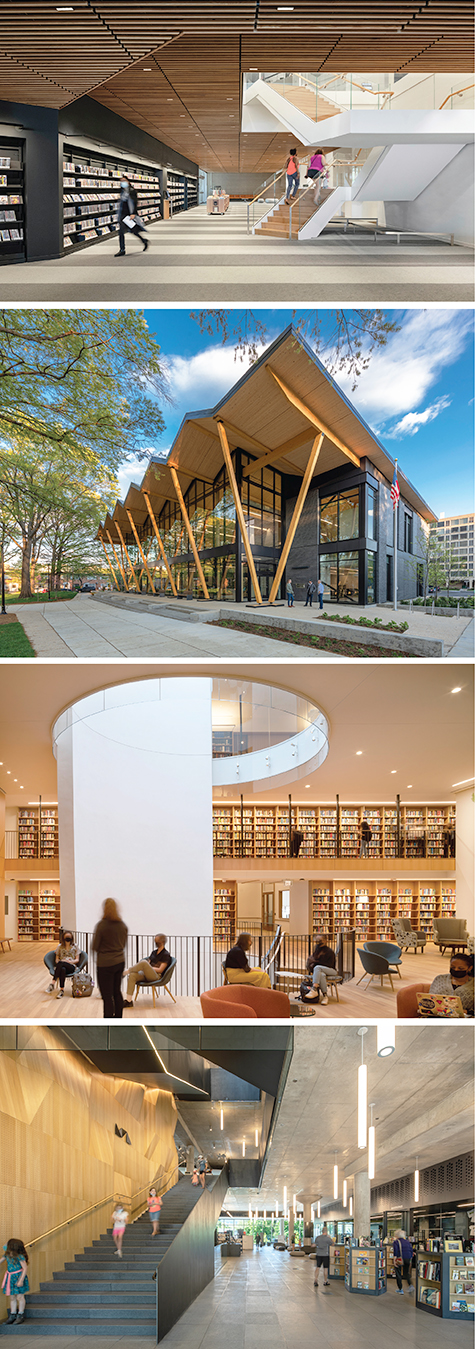Communal Connectors | Year in Architecture 2021
Using sustainable design, organic aesthetics, and materiality, this year’s new and renovated libraries are activating communities by offering a bevy of richly resourced experiences anchored in well-being.
 |
|
NEXT LEVEL LIBRARIES Projects completed in 2021 reach new heights by implementing trends including warm, natural neutrals and richly textured materials. Photos (top to bottom): 1. Skokie Public Library, IL. CREDITS: Andrew Berman Architect, architect; Michael Moran, photo. 2. Southwest Library, Washington DC Public Library. CREDITS: Perkins + Will, architect; photo ©2021 James Steinkamp Photography. 3. Nielson Library, Smith College, Northampton, MA. CREDITS: Maya Lin Studio, Bialosky New York, Shepley Bulfinch, architects; Nic Lehoux, photo. 4. Missoula Public Library, MT.CREDITS: MSR Architects, A&E Design, architects; Lara Swimmer, photo. |
Using sustainable design, organic aesthetics, and materiality, this year’s new and renovated libraries are activating communities by offering a bevy of richly resourced experiences anchored in well-being
In this year’s new and renovated academic and public libraries, subdued and simplified palettes let the materiality of furniture, fixtures, and features take front and center stage. These palettes are carefully balanced with more vibrant accents that vitalize spaces of activity like makerspaces or teen and children’s areas. Materiality, site and function responsiveness, and a continued commitment to innovation in sustainable design are hallmarks of many of this year’s libraries.
MULTIFACETED CREATION AND CONNECTION
We see a continued evolution to makerspaces and entrepreneurial centers, with libraries offering comprehensive centers of making and creation that combine and align multimedia production tools with 3D printers and business services
For example, patrons at the 169,641-square-foot expanded Fayetteville Public Library, AR, can now participate in culinary training in the full-sized commercial teaching kitchen or use any of the fabrication, photography, or virtual reality resources in the Innovation Center.
Bright yellow ceiling-mounted cord storage at the newly constructed LEED Gold Kearns branch of the Salt Lake County Library, UT, provides a pop of color to complement the bright and cheerfully multicolored hard flooring. Children’s sized tables and chairs ensure the makerspace is appropriate to a variety of ages and sizes.
The boldly emblazoned “CREATE,” “MEET,” and “DESIGN” spaces, designed by MSR Design, of the Unbound Library branch of the Meridian District Library, ID, take full advantage of the 3,670-square-foot renovated space. Featuring fabrication equipment, a coworking area, meeting rooms, and a recording studio, the business and technology branch features fully accessible non-gendered restrooms and accessible entrances.
RESPOND AND REFLECT
Our 2021 libraries continue to offer their communities innovative examples of how buildings can give back through thoughtful environmental design in their infrastructure and operations.
At Brooklyn Public Library’s Greenpoint Library and Environmental Education Center, designed by Marble Fairbanks, the traditional library has been transformed into a modern educational center at 15,000 gross square feet—double the size of the original building. Every aspect of the building imparts education about the environment and sustainability. Annually, solar panels produce 19,000 kilowatts, and four windows on the first floor mark the solstice and equinox. A cistern in the reading garden waters educational plantings.
The 20,000-square-foot Southwest Library is the first Washington, DC, Public Library location to receive a LEED Platinum rating. Conceived as a pavilion in the park emphasizing connection to outdoors, the building features dowel-laminated timber with a folded plate roof that significantly reduced the project’s construction waste on-site. A curtain wall offers views overlooking mature trees and a welcoming children’s play area.
MATERIALITY ON THE RISE
In previous years, a plethora of bright, saturated colors dominated the colorways and stories of libraries, both academic and public. Now—thanks in part to innovations in manufacturing that make fabrics more versatile, sustainable, and easy to clean—color is yielding to textures, patterns, and organic forms.
Featuring rich wood tones and slate wall cladding, the Norwell Public Library, MA, offers an intimate courtyard with views into the vast surrounding wooded wetlands. An exposed mass timber structure made of glulam beams connects the library to its wooded surroundings and warms to the interior. Seating is plush but subdued and offers a richly hued blue complement to the landscape and wood features.
EXPERIENTIAL INTENTIONALITY
Aligning wayfinding, wellness-centered design, and biophilic principles, our 2021 libraries are intentionally supporting and celebrating their diverse communities through design.
The renovated Skokie Public Library, IL, designed by Andrew Berman Architect, responded to community needs by creating a new adult and teen makerspace with additional digital media studios, more comfortable and accessible restrooms, contrasting light and dark spaces, and better pathways and sightlines throughout the interior.
Students and faculty alike will enjoy a monumental staircase activating the oculus that anchors the addition to the Neilson Library at Smith College in Northampton, MA. Renovated by Maya Lin Studio, Bialosky New York, and Shepley Bulfinch, the 131,000-square-foot new wing offers its academic community a variety of types of spaces through its five floors. Students can use a reflection room, a reading room and terrace, and the resources in the learning commons or digital media hub.
At the New York Public Library’s Stavros Niarchos Foundation Library (for more information, see “A Fresh Start” ), sightlines offer a view into the full-height book stacks, but suspended sound baffles, hued in the same warm wood tones as the wooden table that wraps around a supporting column, create a more intimately scaled experience for people to pull up a chair and rest, reflect, or engage.
Featuring richly toned woods, human-scaled nooks, and embedded entries, and making elegant use of natural lighting solutions, these libraries bring vibrancy, inspiration, choice of experience, and increased functionality and accessibility to their served communities.
Emily Puckett Rodgers is the manager of the Library Environments department at the University of Michigan Library, Ann Arbor.
RELATED
ALREADY A SUBSCRIBER? LOG IN
We are currently offering this content for free. Sign up now to activate your personal profile, where you can save articles for future viewing









Add Comment :-
Comment Policy:
Comment should not be empty !!!